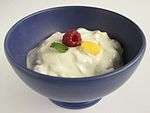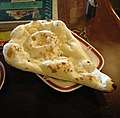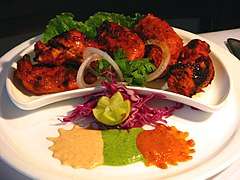Raita
Riti raita is a condiment in South Asian cuisine made of dahi (yogurt, often referred to as curd) together with raw or cooked vegetables, more seldom fruit, or in the case of boondi raita, with fried droplets of batter made from besan (chickpea flour, generally labeled as gram flour).
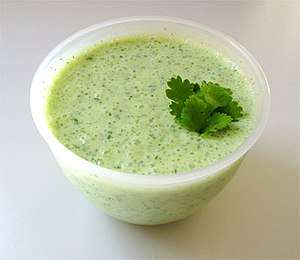 A cucumber and mint raita | |
| Alternative names | रायता, রায়তা Pachadi |
|---|---|
| Course | Condiment |
| Place of origin | Indian subcontinent |
| Region or state | Indian subcontinent with regional variations |
| Associated national cuisine | India, Bangladesh, Pakistan, Nepal |
| Serving temperature | Cold |
| Main ingredients | Dahi (yogurt), buttermilk, cucumber, mint |
| Variations | Dahi chutney, Pachadi |
| 46 kcal (193 kJ) | |
The closest approximation in western cuisine is a side dish or dip, or a cooked salad. It is often referred to as a condiment, but unlike traditional western condiments like salt, pepper, mustard and horseradish that make dishes more spicy, a dish of dahi or raita has a cooling effect to contrast with spicy curries and kebabs that are the main fare of some Asian cuisines. In Indian cuisine, some type of flatbread may be eaten together with raita, chutneys and pickles.
The yogurt may be seasoned with coriander, roasted cumin seeds; mint, cayenne pepper, chaat masala and other herbs and spices.
Etymology
The word raita first appeared in print around the 19th century; it comes from the Hindi language.[1] The word raita in Bengali language and Hindustani is a derivative or portmanteau of the Sanskrit word rajika, meaning black mustard, and tiktaka, meaning sharp or pungent.[2] In South India, especially Kerala and Tamil Nadu, traditional raita is called pachadi.
Raita is also sometimes simply called dahi, or "sourmilk", after its main ingredient, particularly in South African Indian cuisine.
Preparation
Cumin (zīrā ) and black mustard (rāī ) are fried. This tempering is then mixed with minced, raw vegetables or fruits (such as cucumber, onion, carrot, pineapple, papaya) and yogurt.[3]
Raw ginger and garlic paste, green chili paste, and sometimes mustard paste are used to enrich flavour.
A variety of raita of India varies from region to region, most notable raithas are boondi raitha—tiny balls of fried gram flour (chickpea flour), which may taste salty or tīkhā (spicy) and onion raita and vegetable raita. The mixture is served chilled. Raita may cool the palate when eating spicy Indian dishes.[4]
Pachadi
Pachadi is the South Indian variation of Raita.
Variants
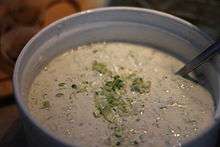
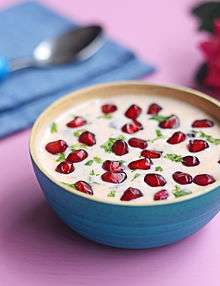
Raitas can be prepared with three main base ingredients: vegetables, pulses and fruits. These are mixed with yogurt and flavoured with a variety of seasonings to make different types of raita.[5]
Vegetable raitas
- Bathua ka Raita, popular in Haryana in winters[6]
- Cucumber raita
- Lauki (Bottle Gourd/Calabash) Raita, popular in Haryana
- Beetroot raita
- Brinjal raita
- Carrot raita
- Chili salt raita, could be chopped fresh chilies or just the dried chili powder
- Horned melon raita
- Mint and peanut raita
- Onion coriander spring onion raita
- Onion tomato raita
- Potato raita
- Pumpkin raita
- Spinach raita
Pulse raitas
Made either from sprouted pulses, roasted pulses or other condiments made from pulse flour.
Fruit raitas
- Banana raita
- Mango raita
- Guava raita
- Grape raita
- Pineapple raita
- Pomegranate raita
- Pear raita
Serving methods
As a side dish
Raita is served as a side dish to be eaten with main course dishes.[5]
As a sauce (not traditional)
- Grilled Chicken
- Salmon
- Tacos
As a dressing (not traditional)
- Salads
- Budda Bowl
- Pasta Salad
See also
| Wikibooks Cookbook has a recipe/module on |
Tzatziki, a similar dish found in Eastern Mediterranean and Middle Eastern cuisine
- Lists
References
- Sedgwick, Fred (2009). Where words come from: A dictionary of word origins. London: Continuum International Publishing group. ISBN 9781847062741.
- "Raita". Merriam Webster.
- Mehta Gambhir, Aloka (25 May 2011). "Tandoori chicken with Tomato Raita". The Times of India. Retrieved 22 December 2019.
- American Dietetic Association (2009). Cultural Food Practices. American Dietetic Associat. p. 244. ISBN 9780880914338.
- Basic Food Preparation (Third Edition). Orient Longman Private limited. 1986. ISBN 81-250-2300-3.
- Bathua ka Raita | Haryana bathua recipe | Indian cuisine, masterchefu.com.
